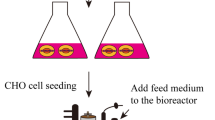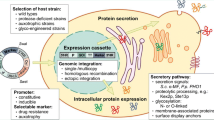Abstract
We have produced a recombinant C-terminal α-amidating enzyme (799BglIIα-AE) derived from Xenopus laevis by culturing a CHO cell line named 3μ-1S. Recently, we demonstrated that culturing 3μ-1S cells at a temperature below 37 °C led to the following phenomena: inhibited cell growth with high viability, enhanced cellular productivity (maximally at 32 °C), and suppressed medium consumption and release of impurities from the cells. Therefore, it is suggested that the 799BglIIα-AE production will be increased by culturing a sufficient number of the cells at a low temperature (especially at 32 °C). To assess this effect on batch and perfusion cultures, the culture temperature was shifted from 37 to 32 °C in the mid-exponential phase in the case of batch culture and from 37 to 34 °C when the cell density became high enough in the case of perfusion culture. Application of the low temperature culture to batch and perfusion cultures was effective in comparison with the culture at 37 °C: the productivity per medium and the productivity per time were increased severalfold with enhanced cellular productivity at a low culture temperature. The low temperature culture also increased the relative content of 799BglIIα-AE in the supernatant and reduced the glucose consumption. The method presented here would contribute to production of bioactive proteins using other recombinant cell lines.
Similar content being viewed by others
References
Borth N, Heider R, Assadian A and Katinger H (1992) Growth and production kinetics of human × mouse and mouse hybridoma cells at reduced temperature and serum content. J Biotechnol 25: 319–331.
Bradbury AF, Finnie MDA and Smyth GG (1982) Mechanism of C-terminal amide formation by pituitary enzymes. Nature 305: 686–688.
Chevrier-Miller M, Morange M, Arrigo AP and Pinto M (1996) Low temperature enhancement of reporter genes expression directed by human immunodeficiency virus type 1 long terminal repeat. Biochem Biophys Res Comm 228: 695–703.
Chuppa S, Tsai Y-S, Yoon S, Shackleford S, Rozales C, Bhat R, Tsay G, Matanguihan C, Konstantinov K and Naveh D (1997) Fermentor temperature as a tool for control of high-density perfusion cultures of mammalian cells. Biotechnol Bioeng 55: 328–338.
Eiper BA, Mains RE and Glembotski CC (1983) Identification in pituitary tissue of a peptide α-amidation activity that acts on glycine-extended peptides and requires molecular oxygen, copper, and ascorbic acid. Proc Natl Acad Sci USA 80: 5144–5148.
Furukawa K and Ohsuye K (1998) Effect of culture temperature on a recombinant CHO cell line producing a C-terminal α-amidating enzyme. Cytotechnology 26: 153–164.
Furukawa K, Okuno K, Onai S, Sugimura K, Yoko-o Y, Ishibashi Y, Ohshima T, Tsuruoka N, Magota K, Tanaka S and Ohsuye K (1993) Production of an α-amidating enzyme (α-AE) in recombinant CHO cells. In: Kaminogawa S et al. (eds.) Animal Cell Technology: Basic and Applied Aspects, Vol. 5 (pp. 493–499) Kluwer Academic Publishers, The Netherlands.
Giard DJ and Fleischaker RJ (1980) Examination of parameters affecting human interferon production with microcarrier-grown fibroblast cells. Antimicrob. Agents Chemother 18: 130–136.
Giard DJ, Fleischaker RJ and Fabricant M (1982) Effect of temperature on the production of human fibroblast interferon (41411). Proc Soc Exp Biol Med 170: 155–159
Kato I, Yonekura H, Tajima M, Yanagi M, Yamamoto H and Okamoto H (1990) Two enzymes concerned in peptide hormone-amidation are synthesized from a single mRNA. Biochem Biophys Res Comm 172: 197–203.
Kojima Y and Yoshida F (1974) Enhanced production of interferon by temperature shift-down from 37 °C to 25 °C in rabbit cell cultures stimulated with Newcastle disease virus. Japan J Microbiol 18: 217–222.
Mizuno K, Ohsuye K, Wada Y, Fuchimura K, Tanaka S and Matsuo H (1987) Cloning and sequence of cDNA encoding a peptide C-terminal α-amidating enzyme from Xenopus laevis. Biochem Biophys Res Comm 148: 546–552.
Mizuno K, Sakata J, Kojima M, Kangawa K and Matsuo H (1986) Peptide C-terminal α-amidating enzyme purified to homogeneity from Xenopus laevis skin. Biochem Biophys Res Comm 137: 984–991.
Ohsuye K, Kitano K, Wada Y, Fuchimura K, Tanaka S, Mizuno K and Matsuo H (1988) Cloning of cDNA encoding a new peptide C-terminal α-amidating enzyme having a putative membrane-spanning domain from Xenopus laevis skin. Biochem Biophys Res Comm 150: 1275–1281.
Reuveny S, Velez D, Macmillan JD and Miller L (1986) Factors affecting cell growth and monoclonal antibody production in stirred reactors. J Immunol Methods 86: 53–59.
Rasmussen P (1991) Method of producing proteins with FVIII activity and/or FVIII derivatives. Patent WO 91/00347.
Sureshkumar GK and Mutharasan R (1991) The influence of temperature on a mouse-mouse hybridoma growth and monoclonal antibody production. Biotechnol Bioeng 37: 292–295.
Takagi M and Ueda K (1994) Comparison of the optimal culture conditions for cell growth and tissue plasminogen activator production by human embryo lung cells on microcarriers. Appl Microbiol Biotechnol 41: 565–570.
Vilček J and Havell EA (1973) Stabilization of interferon messenger RNA activity by treatment of cells with metabolic inhibitors and lowering of the incubation temperature. Proc Natl Acad Sci USA 70: 3909–3913.
Weidemann R, Ludwig A and Kretzmer G (1994) Low temperature cultivation — A step towards process optimization. Cytotechnology 15: 111–116.
Rights and permissions
About this article
Cite this article
Furukawa, K., Ohsuye, K. Enhancement of productivity of recombinant α-amidating enzyme by low temperature culture. Cytotechnology 31, 85–94 (1999). https://doi.org/10.1023/A:1008059803038
Issue Date:
DOI: https://doi.org/10.1023/A:1008059803038




